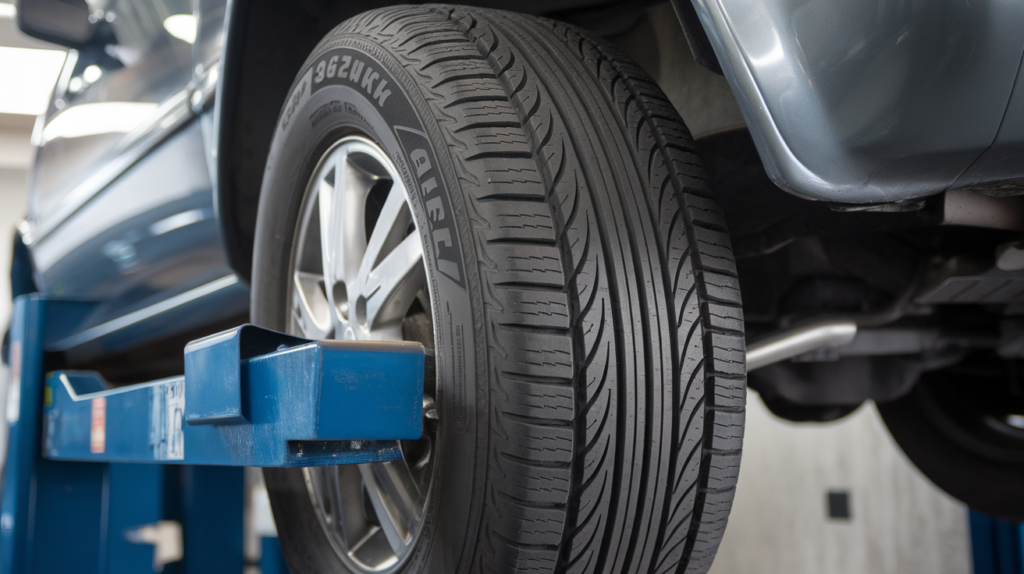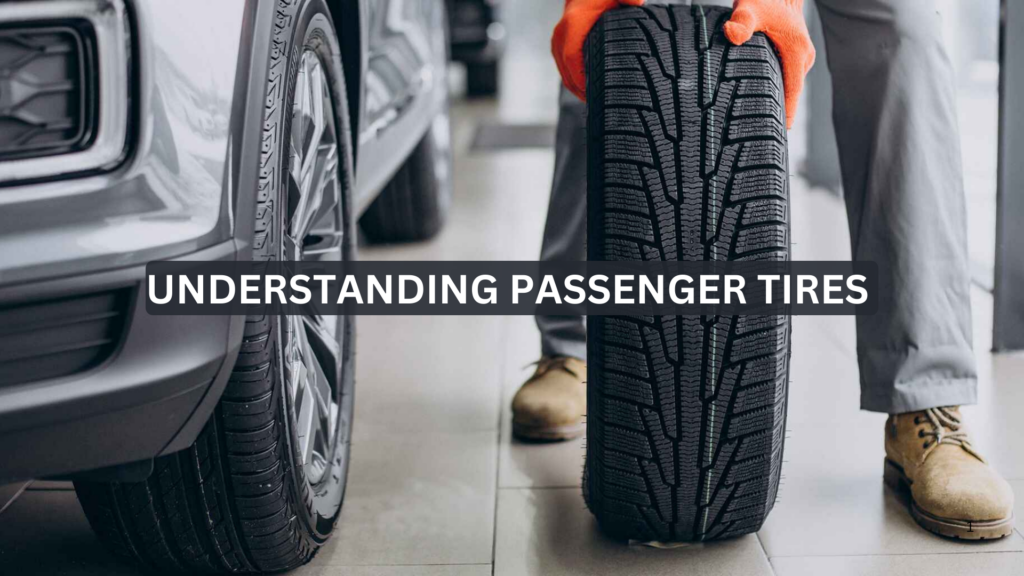Ever feel confused when buying new tires for your car? You’re not alone.
In this guide, I’ll solve this problem by showing you:
- What passenger tires are
- The different types available
- How to read tire sizes
- How to choose the right ones for your needs
- Simple ways to make your tires last longer
Your safety on the road depends on those four rubber circles touching the ground. They’re the only contact between your car and the pavement.
I’ve helped hundreds of drivers make smart tire choices, and now I’ll help you, too.
Whether you are a new car owner or want to understand what you’re paying for at the tire shop, this article has your answers.
Bad tire choices cost money and risk safety. Good decisions do the opposite.
What Exactly Is a Passenger Tire?

A passenger tire is a type of tire specifically designed for cars, minivans, and some light trucks that carry people rather than heavy loads.
These tires focus on providing a comfortable ride, good handling, and reasonable tread life.
Unlike other tire types, passenger tires balance several needs:
- Comfort for daily driving
- Safety in various weather conditions
- Fuel efficiency
- Affordability
Think of passenger tires as all-around performers. They’re like the sneakers of the tire world – versatile enough for most situations but not specialized for extreme conditions.
If you drive a regular car or small SUV, you probably have passenger tires on your vehicle right now.
Types of Passenger Tires
Different driving needs call for different tire types. Choosing the right tires for your car matters more than you might think. Passenger tires come in different types, each serving a specific purpose. Let’s look at the most common options.
Here’s a breakdown of the main passenger tire categories:
| Tire Type | Best For | Key Features | Typical Lifespan |
|---|---|---|---|
| All-Season | Year-round driving in mild climates | Balance of wet/dry traction, comfortable ride | 50,000-80,000 miles |
| Summer | Warm weather performance | Better handling, stronger grip in heat | 25,000-40,000 miles |
| Winter/Snow | Cold weather, ice, snow | Special rubber compounds, deeper treads | 30,000-40,000 miles |
| Touring | Highway driving, comfort | Smoother ride, less road noise | 60,000-90,000 miles |
| Performance | Sports cars, spirited driving | Better cornering, handling | 20,000-50,000 miles |
| All-Terrain | Light off-road use | More aggressive tread, tougher sidewalls | 40,000-60,000 miles |
| Low Rolling Resistance | Fuel efficiency | Special compounds to reduce friction | 40,000-70,000 miles |
The most common type is all-season tires because they work well enough in most conditions.
But you might need something more specialized if you live somewhere with harsh winters or drive a sports car.
Understanding Passenger Tire Sizes
Understanding passenger tire sizes doesn’t have to feel confusing. I’ve been there, staring at those numbers, wondering what they mean. Let me break it down simply for you.
Have you ever looked at the side of your tire and seen a code like “P215/65R16 95H”? That’s your tire size.
Here’s what it means:
- P: Stands for “Passenger” tire
- 215: The width of the tire in millimeters
- 65: The aspect ratio (sidewall height as a percentage of the width)
- R: Radial construction (how the tire is built)
- 16: The wheel diameter in inches
- 95H: Load index and speed rating
Why does this matter to you?
Getting the right size ensures your car handles properly and your speedometer works correctly. Using the wrong size can be dangerous.
Finding your tire size is easy. Look on:
- The driver’s side door jamb
- Your owner’s manual
- The sidewall of your current tires
When in doubt, ask a tire professional to help you match the right size for your vehicle.
How Passenger Tires Differ from Other Tire Types
Passenger tires aren’t the same as other tire types—they’re built specifically for comfort and daily driving. Knowing these differences can help you pick the right tires for your needs and avoid issues.
Here’s how passenger tires compare to other common types:
| Feature | Passenger Tires | Light Truck Tires | Commercial Tires | Performance Tires |
|---|---|---|---|---|
| Load Capacity | Lower | Higher | Highest | Varies |
| Sidewall Strength | Standard | Reinforced | Heavy-duty | Often softer |
| Comfort Level | High | Medium | Low | Medium-Low |
| Noise Level | Quieter | Louder | Loudest | Often louder |
| Tread Life | 50,000-80,000 miles | 40,000-60,000 miles | 60,000-100,000 miles | 20,000-40,000 miles |
| Price Range | $80-$200 each | $150-$350 each | $200-$500+ each | $150-$400+ each |
| Fuel Efficiency | Better | Worse | Worst | Often worse |
The main takeaway? Passenger tires prioritize your comfort and fuel economy over heavy-duty capability. Passenger tires are likely your best bet if you mainly drive on roads and highways.
Choosing the Right Passenger Tire for Your Vehicle
Picking the right passenger tire can make driving safer and smoother. I’ve found that tires affect everything from fuel use to comfort. Finding the perfect tire doesn’t have to be overwhelming.
Here’s my simple approach:
Know Your Driving Habits
- Do you drive mostly on highways or cities?
- What’s the weather like where you live?
- How long do you want your tires to last?
Set a Budget
- Remember: Tires are not where you want to cut corners on quality
- Good tires typically cost $100-$200 each for most passenger cars
- Installation usually adds $15-$30 per tire
Check Reviews
- Look for tires with good ratings for the features you care about
- Ask friends or family about their experiences
Important factors to consider:
- Tread life warranty
- Wet/dry performance
- Road noise
- Ride comfort
- Fuel economy impact
Don’t just buy the cheapest option! A good set of tires might cost more upfront but save you money on fuel and last longer.
Passenger Tire Maintenance Tips
Taking care of your passenger tires isn’t hard, but skipping maintenance can cost you in the long run. I’ve found a few simple steps that keep tires safe and extend their life. Let me share these quick tips with you.
Here’s what you should do:
Check tire pressure monthly: Low pressure wears tires faster and wastes gas. The correct pressure is listed on a sticker inside your driver’s door jamb—not on the tire itself!
Rotate your tires every 5,000-7,000 miles: This helps them wear evenly and last longer.
Look at the tread depth: Stick a penny in the tread with Lincoln’s head upside down. If you can see all of his head, your tires need replacement.
Watch for uneven wear patterns: They might signal alignment problems that need fixing.
Keep your tires clean: Mud and grime can hide damage and cause issues over time.
The best part? Most of these checks take just a minute or two. That small effort can add thousands of miles to your tire life!
Common Myths About Passenger Tires
When I first started learning about passenger tires, I heard plenty of advice—but not all was true. To help you avoid confusion, I’ll clear up some common myths about tires that many drivers still believe.
Let’s bust some tire myths that might be costing you money:
Myth 1: All Black Tires Are Basically the Same
Truth: Tire brands and models have huge differences in quality, tread design, and rubber compounds.
Myth 2: You Should Always Replace All Four Tires at Once
Truth: While ideal, you can replace just two if needed (but put them on the rear axle for safety).
Myth 3: Tire Pressure Should Match the Number on The Tire’s Sidewall
Truth: Follow the pressure listed on your vehicle’s door jamb or in the owner’s manual instead.
Myth 4: Premium Tires Are Just a Waste of Money
Truth: Better tires often last longer and can improve safety and fuel economy.
Myth 5: You Don’t Need Winter Tires if You Have All-Wheel Drive
Truth: AWD helps you go in snow but doesn’t help you stop—winter tires do that.
Understanding these facts can help you make smarter decisions about your tires.
Conclusion
Your tires are your vehicle’s foundation. Choose wisely, and they’ll serve you well.
Throughout this guide, we’ve covered the essentials of passenger tires – from types and sizes to maintenance and myth-busting.
Remember these key points:
- Match tire type to your driving conditions
- Regular pressure checks extend tire life
- Proper maintenance saves money in the long run
- The right tires improve safety and fuel economy
Making informed tire decisions isn’t just about saving money– it’s about protecting yourself and your passengers on every trip.
Now, you have the knowledge to choose tires with confidence instead of confusion. You know what questions to ask and what features matter most for your specific needs.
Your future rides will be safer, smoother, and more economical because of it.
Frequently Asked Questions
How Long Do Passenger Tires Typically Last?
Most passenger tires last between 40,000-80,000 miles, depending on the type, quality, driving habits, and maintenance.
Can I Mix Different Tire Brands on My Car?
While possible, it’s not recommended. Different brands have different handling characteristics that could affect your vehicle’s stability.
Do I Really Need to Buy Winter Tires if I Live Where It Snows?
If you regularly drive in temperatures below 45°F (7°C) or on snow and ice, winter tires provide significant safety benefits that all-season tires can’t match.
What Does the Speed Rating on My Tire Mean?
The speed rating (letters like H, V, or Z) indicates the maximum safe speed the tire can handle when properly inflated and not worn out.


